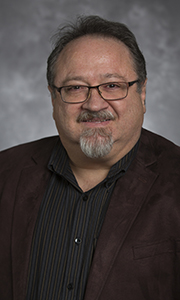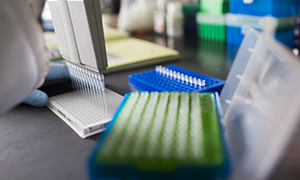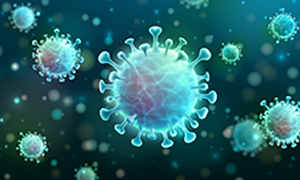Researching SARS-CoV-2
Making SARS-CoV-2 Safer to Study
Stefan Sarafianos is making the study of SARS-CoV-2 faster, cheaper, safer, and much more efficient.
Sarafianos, a professor in the Emory University School of Medicine, recently led the development of a SARS-CoV-2 subgenomic replicon system, including mutants, that can be used for high-throughput screening and characterization of SARS-CoV-2 replicase inhibitors at a lower biosafety level. This will create considerable benefits for drug discovery studies.

Stefan Sarafianos
About the work of his lab team, Sarafianos notes: “We have strengthened efforts to understand how drugs work and how they fail at the molecular level.”
Understanding a large, deadly virus – safely
Replicons use only part of a virus’ genome, which makes it noninfectious yet still able to imitate the replication processes that are of interest for drug discovery.
This concept has already existed for life-threatening viruses such as hepatitis C, but that doesn’t mean it’s been easy to apply to SARS-CoV-2. As the largest of the RNA viruses, SARS-CoV-2 is a “tough one to work with because it is three times larger than HIV. It is complicated but that is also what makes it fascinating and challenging to study,” says Sarafianos.

High-Throughput Screening
There’s also the problem of logistics. In addition to the high cost of facilities in which you can safely study airborne pathogens, there is a high regulatory burden that accompanies that research. In the past, several institutions – especially pharmaceutical companies – have been unwilling to house biosafety level-3 (BSL3) labs. This presents a problem of equity: According to Sarafianos, “around the world, there are many researchers who do not have access to BSL3 facilities and need to do BSL3 research.” His breakthrough is significant because the replicon is based on the part of the viral chain that allows replication but is not infectious; therefore, it can be studied in BSL2 facilities worldwide.
Pushing further into SARS-CoV-2 research
With the replicon technology licensed and generating interest from several companies, Sarafianos is pressing ahead with a new technology: making chimaeras that recapitulate the full cycle of the virus in BSL2 conditions. This technology will prove important in generating mutants that can help us better understand drug resistance.
The chimaera adds to the replicon’s capability to create drug-resistant mutations. Like the replicon, the chimaera’s virus-like particles enable studying compounds inside the cell. Unlike the replicon, they also make it possible to probe into how the spike – which sits on the outside of the virus – negotiates entry into a human cell.
“In vaccine research,” observes Sarafianos, “you need to include the spike. Our new constructs do have the spike, but they are rigged to enter only a single cell and stop the virus from spreading to millions of other cells.”
For David Mudd, licensing associate in Emory’s Office of Technology Transfer, applying replicon technology to study SARS-CoV-2 was an important breakthrough. But implementing chimaera technology in the research is a “gamechanger for not only understanding the virus more fully, but also for the future of public health.”
Learning from history
As SARS in 2002–2003 and MERS in 2012 had a relatively low mortality rate – a combined death toll of 1,678 – it wasn’t until the COVID-19 pandemic, which has claimed more than six million lives, that funding for SARS-CoV-2 research expanded.

SARS-CoV-2
“We are getting better at seeing around the corner to expose threats before they escalate,” Sarafianos says. Thus, while research on SARS-CoV-2 started slowly, “the race now is
insane.”
To be part of an “insane” race is anxiety-producing but also motivating. Every morning, Sarafianos logs onto his computer and hopes that he doesn’t get scooped, eager to contribute even more.
And to Sarafianos, there is another silver lining to studying this deadly virus: “The challenges posed by this virus offer an amazing opportunity to train the next generation of virologists. It is so great to get young people excited and motivate them to work on something that serves us all.”
Tech ID: 21046
Read the technology brief.